Mapping Spatial Inequity in Urban Fire Service Provision: A Moran’s I Analysis of Station Pressure Distribution
Abstract
1. Introduction
- Identify the FPs faced by different fire stations in Nanjing.
- Identify the stations’ service strategy for inequivalent FPs in urban areas and check the strategies’ significance.
- Compare the characteristics of different strategies via the spatial autocorrelation check and illustrate the advantages.
2. Application of Spatial Autocorrelation Methods in Infrastructure Planning
3. Data and Methodology
3.1. Data
3.2. Methodology and Research Structure
4. Results and Discussion
4.1. Global Moran’s I
4.2. Localized Moran’s I
4.3. Validation of Inter-Regional Strategy Based on Moran’s I
4.4. Comparison with Other Balancing Approaches
5. Conclusions
Author Contributions
Funding
Data Availability Statement
Conflicts of Interest
References
- Yao, J.; Zhang, X.; Murray, A.T. Location optimization of urban fire stations: Access and service coverage. Comput. Environ. Urban Syst. 2019, 73, 184–190. [Google Scholar] [CrossRef]
- Rie, D.; Ryu, J. Sustainable urban planning technique of fire disaster prevention for subway. Sustainability 2020, 12, 372. [Google Scholar] [CrossRef]
- Cui, S.; Wang, N.; Zhao, E.; Zhang, J.; Zhang, C. Assessing urban fire risk: An ensemble learning approach based on scenarios and cases. Int. J. Disaster Risk Reduct. 2024, 114, 104941. [Google Scholar] [CrossRef]
- Bai, M.; Liu, Q. Evaluating Urban fire risk based on entropy-cloud model method considering urban safety resilience. Fire 2023, 6, 62. [Google Scholar] [CrossRef]
- Xia, Z.; Li, H.; Chen, Y.; Yu, W. Detecting urban fire high-risk regions using colocation pattern measures. Sustain. Cities Soc. 2019, 49, 101607. [Google Scholar] [CrossRef]
- Murray, A.T. Optimising the spatial location of urban fire stations. Fire Saf. J. 2013, 62, 64–71. [Google Scholar] [CrossRef]
- Badri, M.A.; Mortagy, A.K.; Alsayed, C.A. A multi-objective model for locating fire stations. Eur. J. Oper. Res. 1998, 110, 243–260. [Google Scholar] [CrossRef]
- Ferreira, T.M.; Vicente, R.; da Silva, J.A.R.M.; Varum, H.; Costa, A.; Maio, R. Urban fire risk: Evaluation and emergency planning. J. Cult. Herit. 2016, 20, 739–745. [Google Scholar] [CrossRef]
- Svensson, S. A study of tactical patterns during fire fighting operations. Fire Saf. J. 2002, 37, 673–695. [Google Scholar] [CrossRef]
- Brasington, D.M.; Parent, O. Fire protection services and house prices: A regression discontinuity investigation. Reg. Sci. Urban Econ. 2024, 105, 103984. [Google Scholar] [CrossRef]
- Winter, G.; Fried, J.S. Homeowner perspectives on fire hazard, responsibility, and management strategies at the wildland-urban interface. Soc. Nat. Resour. 2000, 13, 33–49. [Google Scholar]
- Zhang, X.; Yao, J.; Sila-Nowicka, K.; Jin, Y. Urban fire dynamics and its association with urban growth: Evidence from Nanjing, China. ISPRS Int. J. Geo-Inf. 2020, 9, 218. [Google Scholar] [CrossRef]
- Yao, M.; Zhang, D.; Chen, Y.; Liu, Y.; Elsadek, M. Urban Fire Risk Dynamics and Mitigation Strategies in Shanghai: Integrating Spatial Analysis and Game Theory. Land 2024, 13, 1125. [Google Scholar] [CrossRef]
- Yu, W.; Chen, Y.; Guan, M. Hierarchical siting of macro fire station and micro fire station. Environ. Plan. B Urban Anal. City Sci. 2021, 48, 1972–1988. [Google Scholar] [CrossRef]
- Yu, Z.; Xu, L.; Chen, S.; Jin, C. Research on urban fire station layout planning based on a combined model method. ISPRS Int. J. Geo-Inf. 2023, 12, 135. [Google Scholar] [CrossRef]
- Lewis, R.H.; Jiao, J.; Seong, K.; Farahi, A.; Navrátil, P.; Casebeer, N.; Niyogi, D. Fire and smoke digital twin—A computational framework for modeling fire incident outcomes. Comput. Environ. Urban Syst. 2024, 110, 102093. [Google Scholar] [CrossRef]
- Corcoran, J.; Higgs, G.; Higginson, A. Fire incidence in metropolitan areas: A comparative study of Brisbane (Australia) and Cardiff (United Kingdom). Appl. Geogr. 2011, 31, 65–75. [Google Scholar] [CrossRef]
- Tian, F.; Lei, J.; Zheng, X.; Yin, Y. Integrating space syntax and location-allocation model for fire station location planning in a China mega city. Fire 2023, 6, 64. [Google Scholar] [CrossRef]
- Moran, P.A.P. Notes on continuous stochastic phenomena. Biometrika 1950, 37, 17–23. [Google Scholar] [CrossRef]
- Xingxing, H.E.; Junjie, R.; Caixing, B. Does Artificial Intelligence Application Promote Green Innovation in Three Major City Clusters of the Yangtze River Economic Belt? Based on the Perspectives of “Digital Dividend” and “Digital Divide”. Econ. Geogr. 2024, 44, 137–147. [Google Scholar]
- Fu, Q.; Zhou, M.; Li, Y.; Ye, X.; Yang, M.; Wang, Y. Flow Spatiotemporal Moran’s I: Measuring the Spatiotemporal Autocorrelation of Flow Data. Geogr. Anal. 2024, 56, 799–824. [Google Scholar] [CrossRef]
- Guliyev, H. Associations of (un) observed factors and gender inequality in European countries: Evidence from spatial panel data model. Appl. Geogr. 2023, 159, 103066. [Google Scholar] [CrossRef]
- Zhang, Y.; Zhao, J.; Mavoa, S.; Smith, M. Inequalities in urban green space distribution across priority population groups: Evidence from Tāmaki Makaurau Auckland, Aotearoa New Zealand. Cities 2024, 149, 104972. [Google Scholar] [CrossRef]
- Floderus, P.; Lingas, A.; Persson, M. Towards more efficient infection and fire fighting. Int. J. Found. Comput. Sci. 2013, 24, 3–14. [Google Scholar] [CrossRef]
- Shaikh, M.K. Application of Deep Learning: A Review for Firefighting. Int. J. Comput. Sci. Netw. Secur. 2022, 22, 73–78. [Google Scholar]
- Dong, X.M.; Li, Y.; Pan, Y.L.; Huang, Y.J.; Cheng, X.D. Study on urban fire station planning based on fire risk assessment and GIS technology. Procedia Eng. 2018, 211, 124–130. [Google Scholar] [CrossRef]
- Yoshida, H.; Omae, M. An approach for analysis of urban morphology: Methods to derive morphological properties of city blocks by using an urban landscape model and their interpretations. Comput. Environ. Urban Syst. 2005, 29, 223–247. [Google Scholar] [CrossRef]
- Xu, X.; Yin, C.; Wang, W.; Xv, N.; Hong, T.; Li, Q. Revealing urban morphology and outdoor comfort through genetic algorithm-driven urban block design in dry and hot regions of China. Sustainability 2019, 11, 3683. [Google Scholar] [CrossRef]
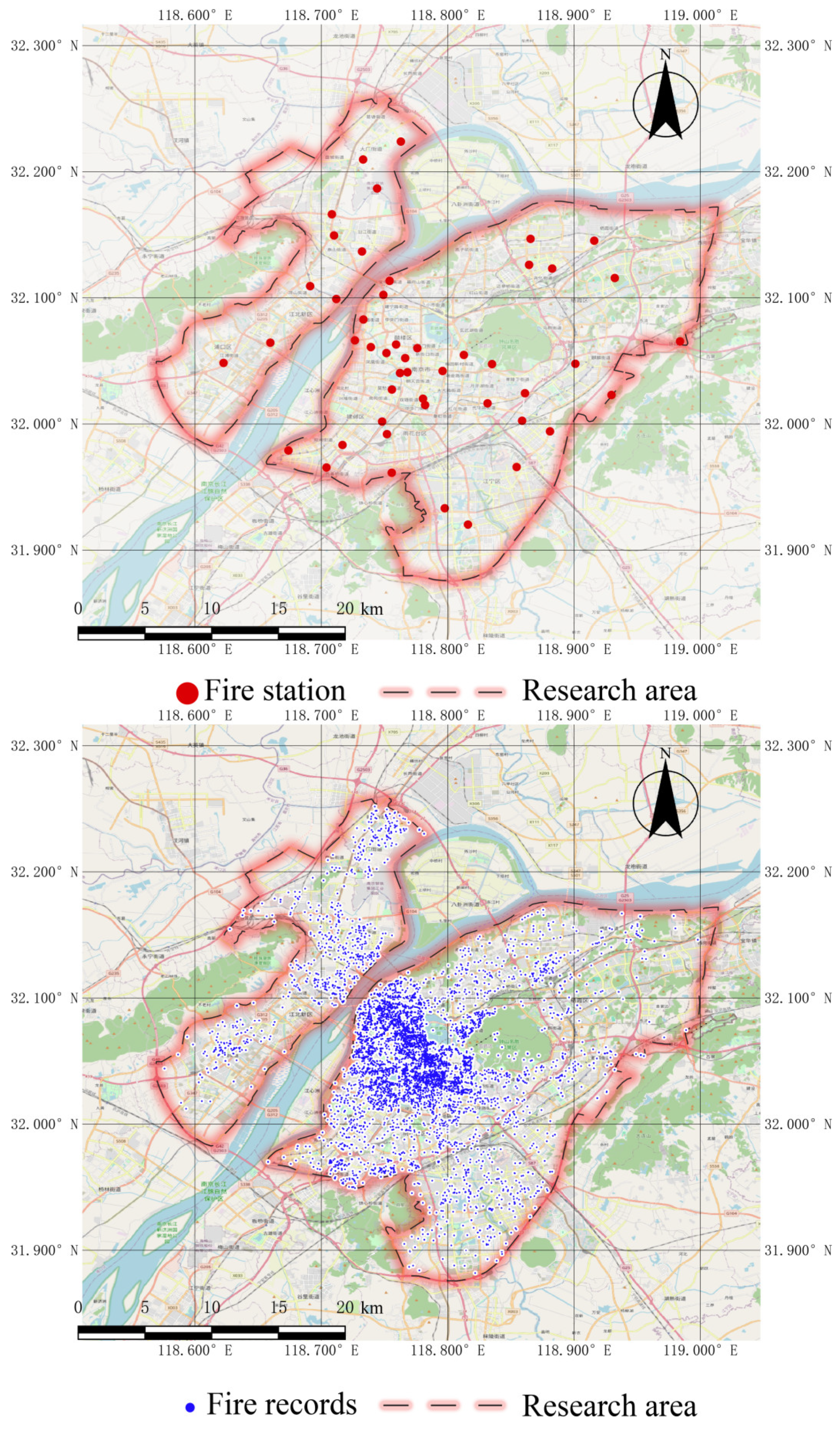

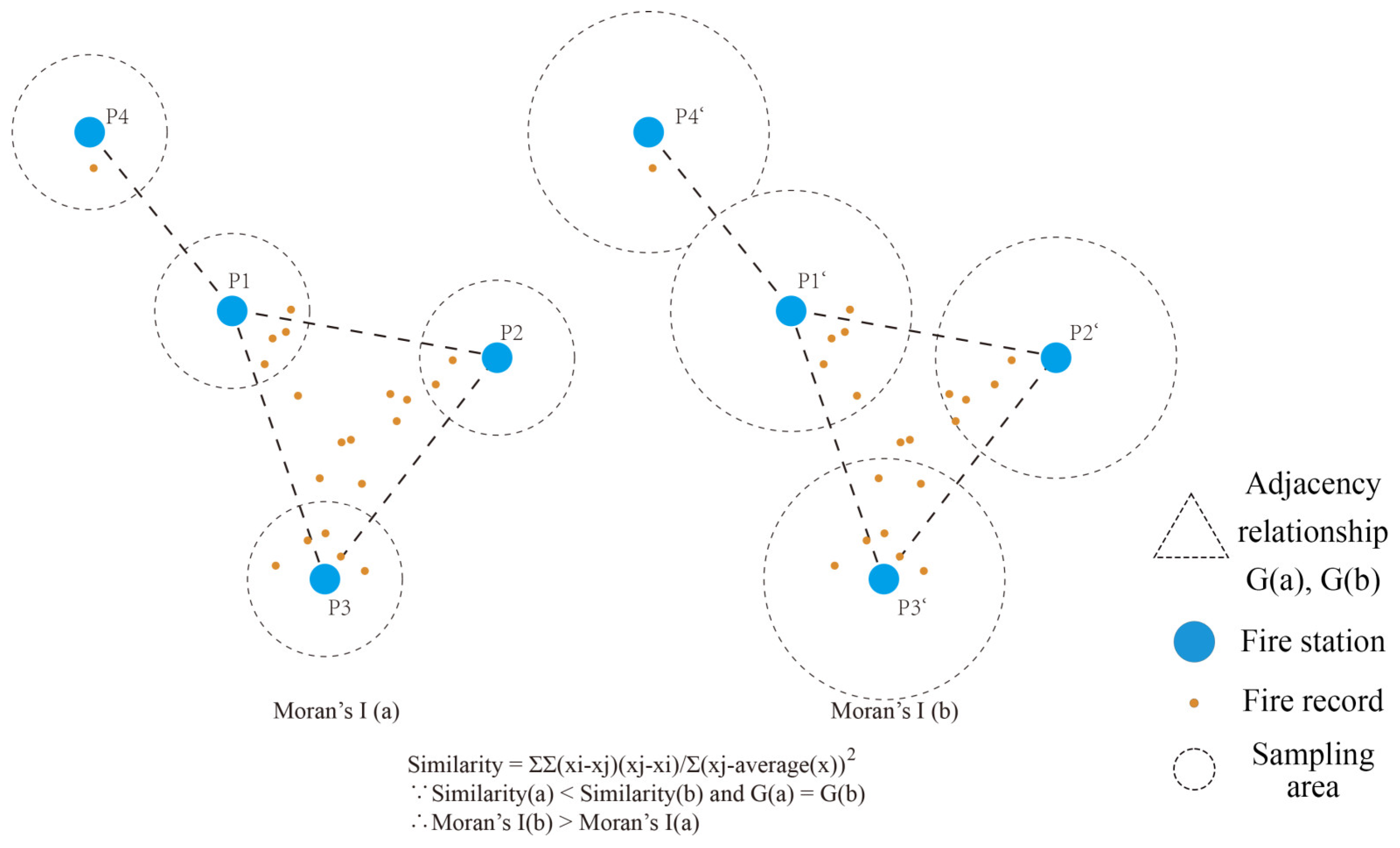
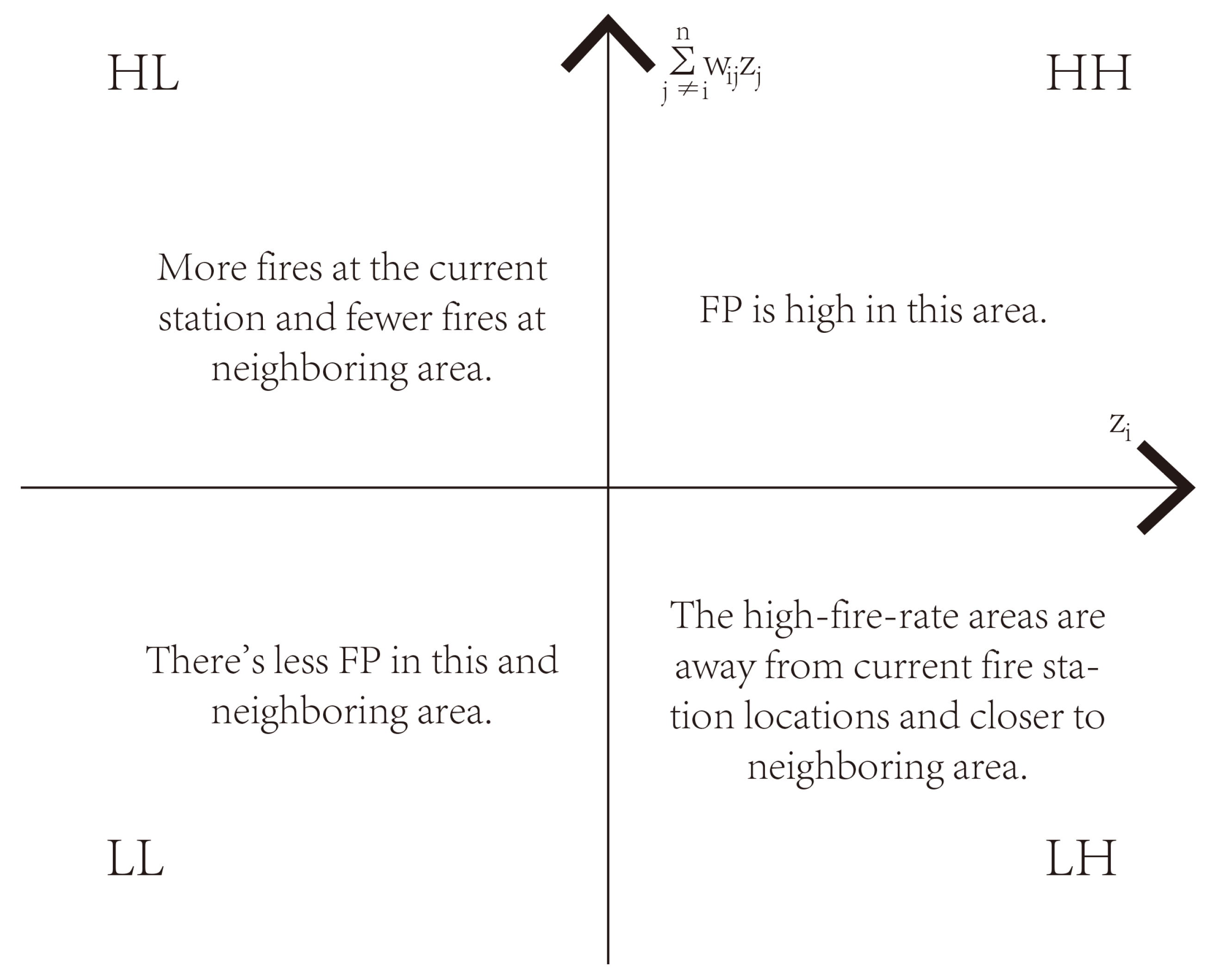
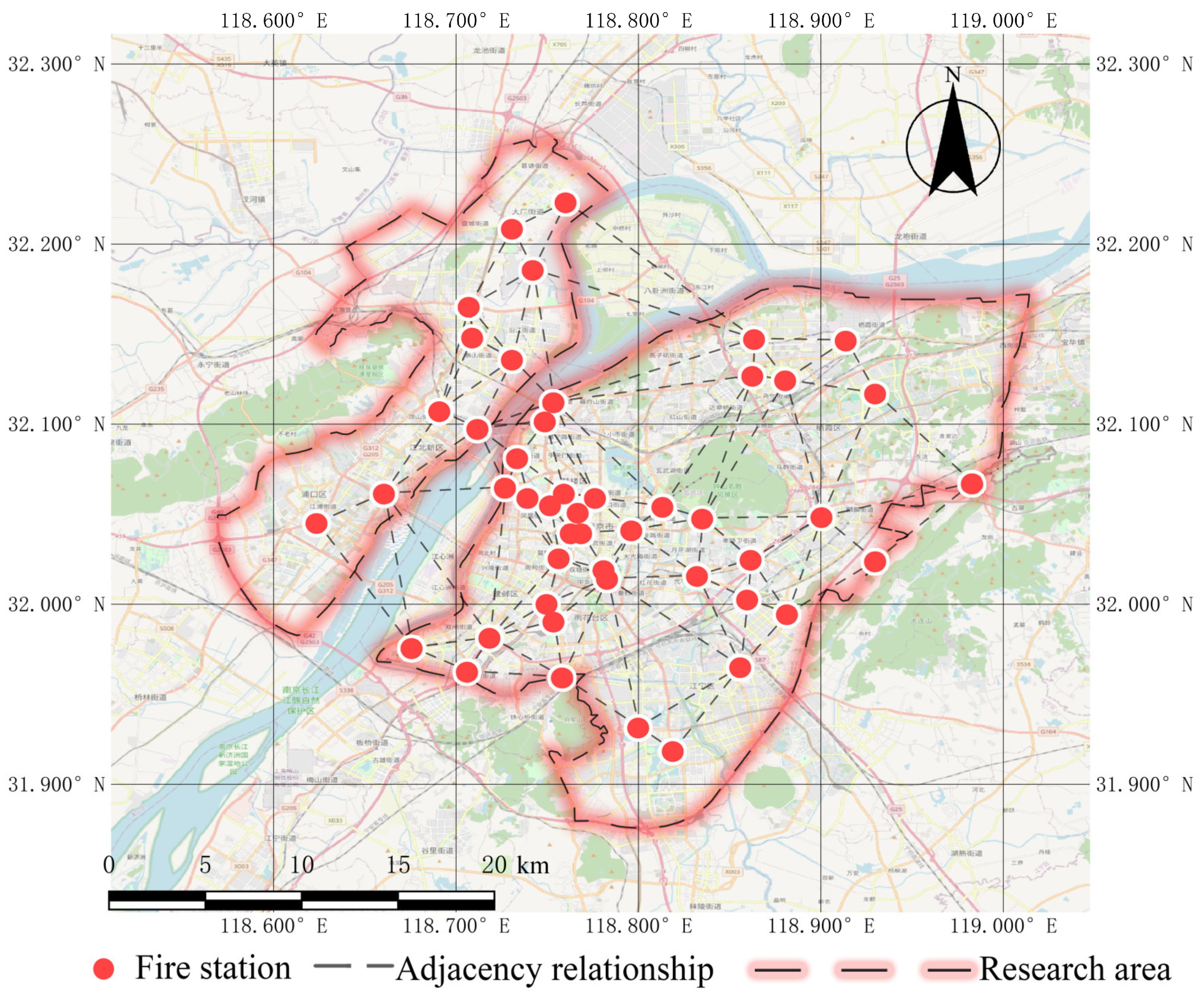
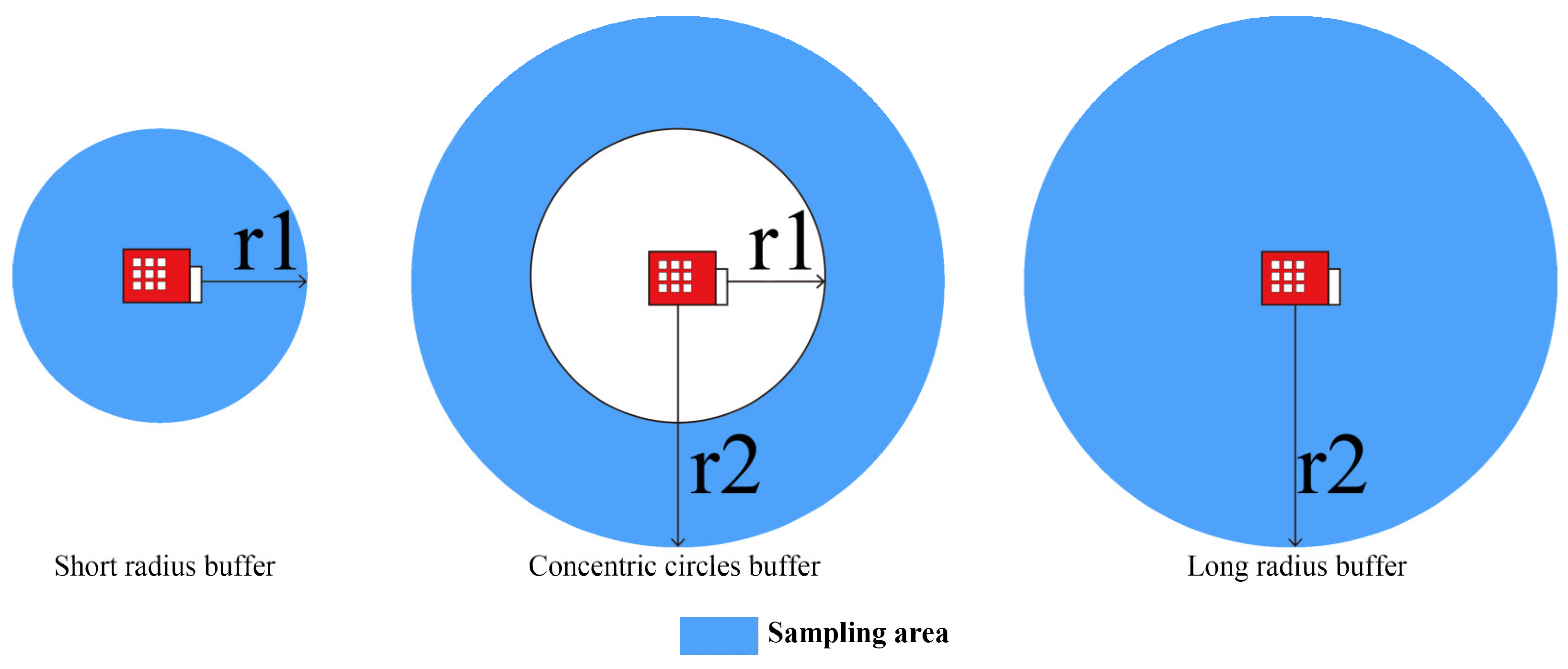
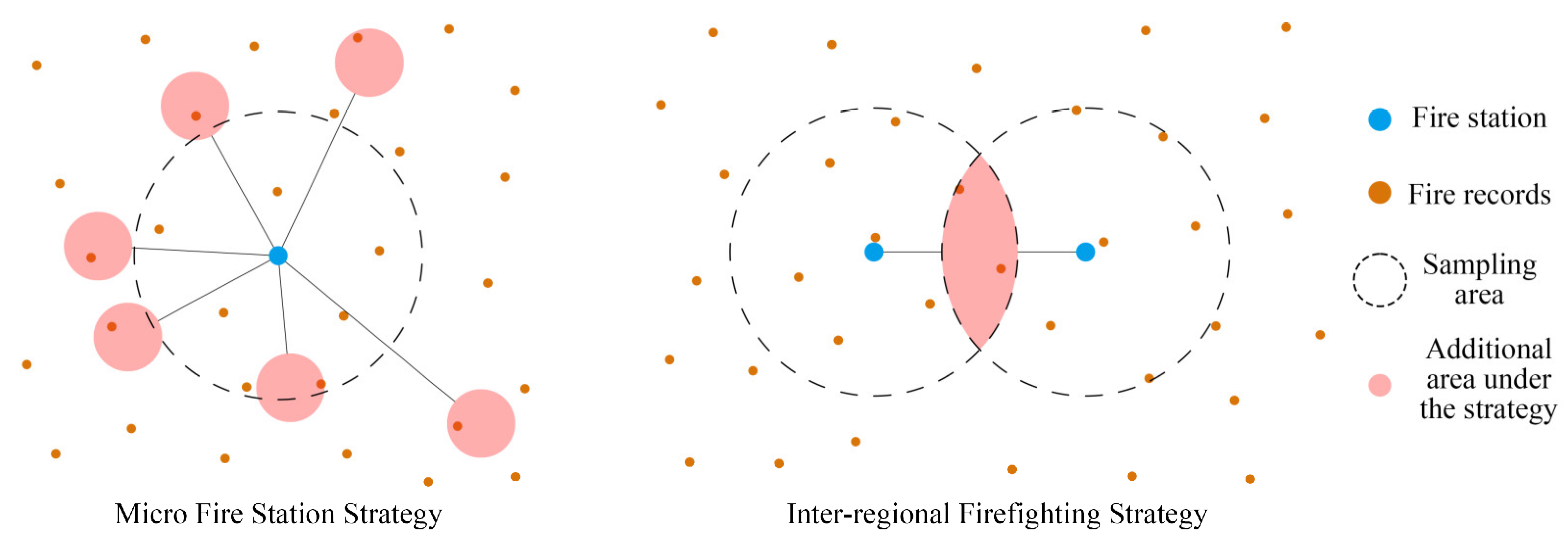
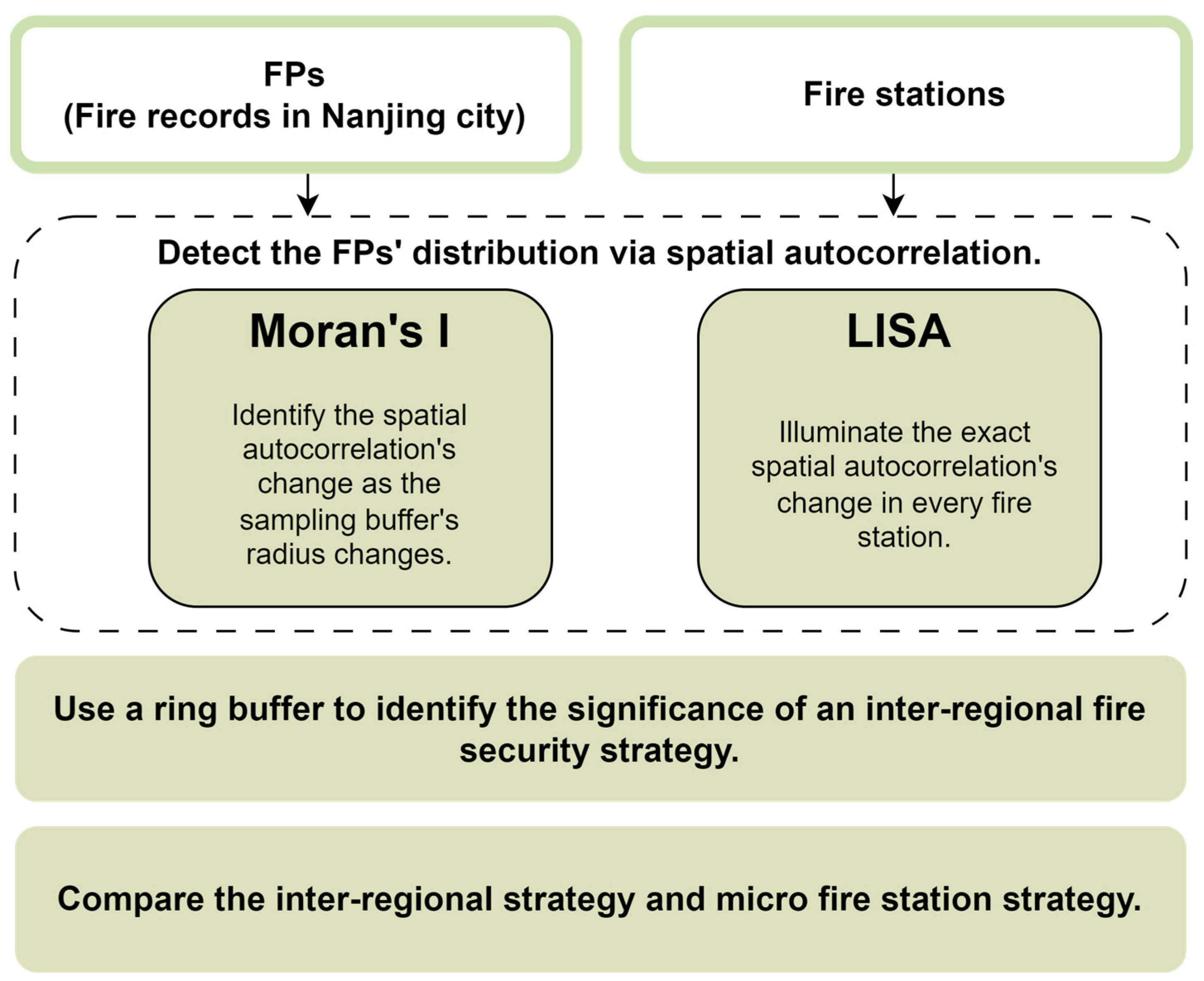

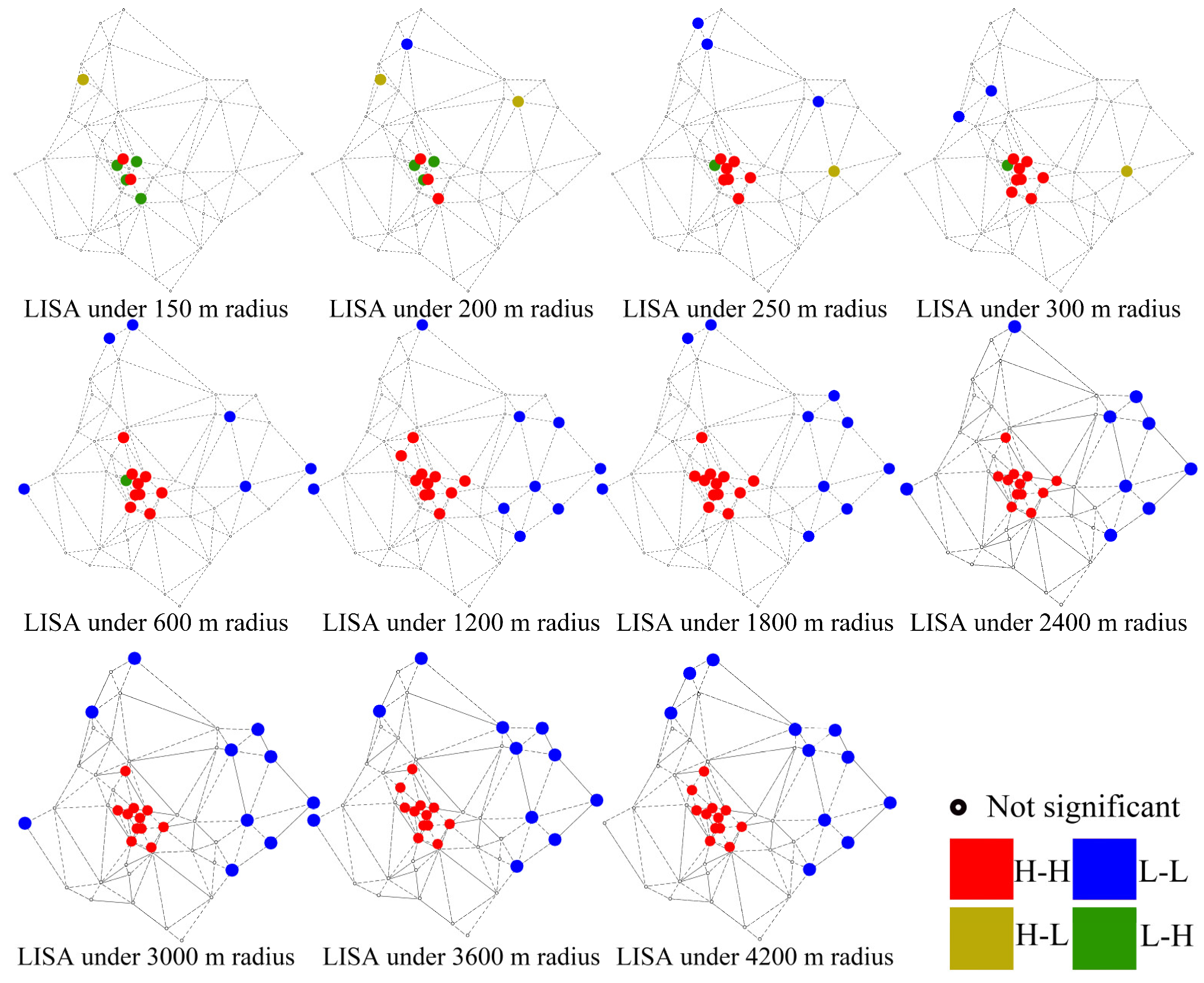
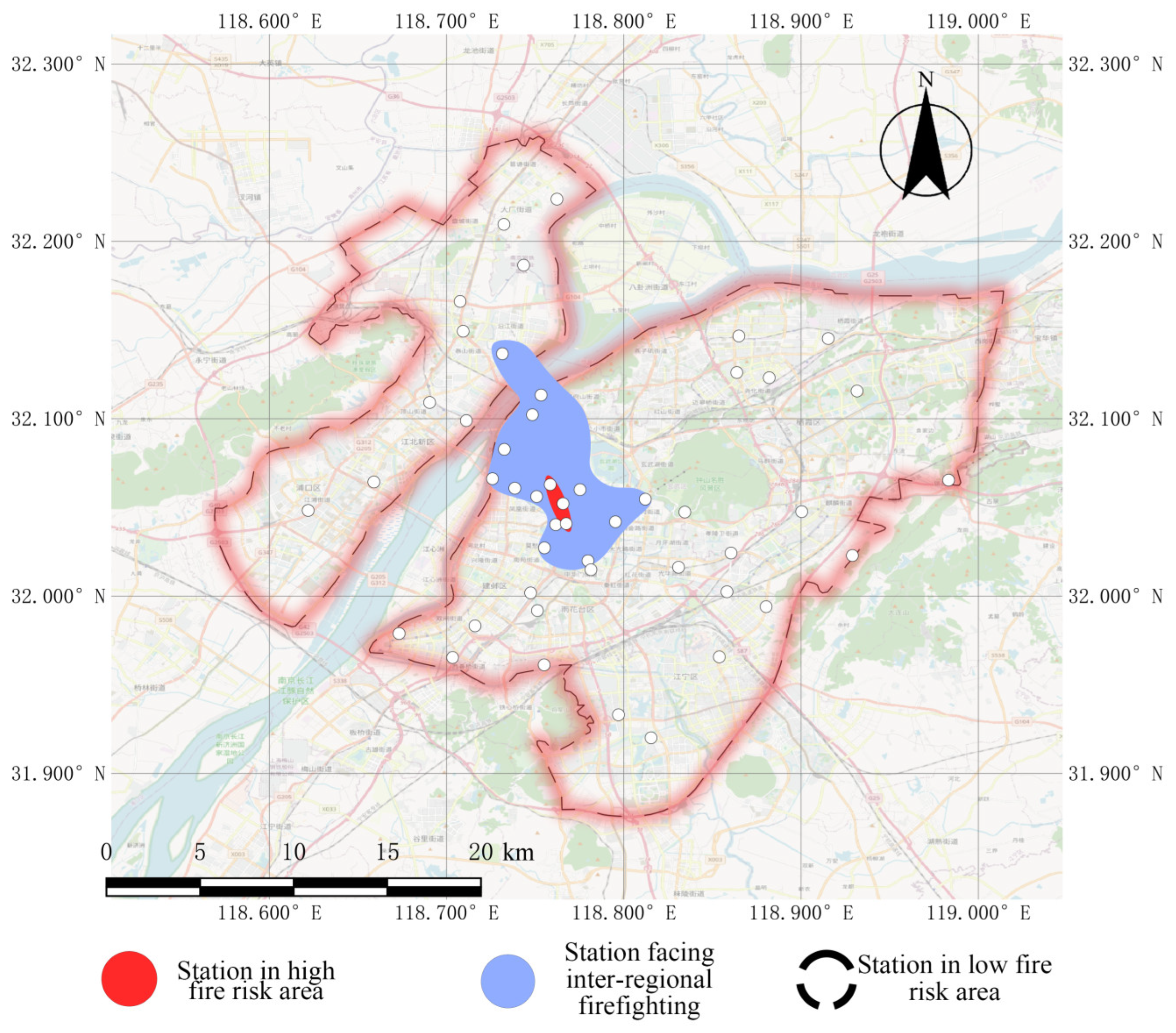
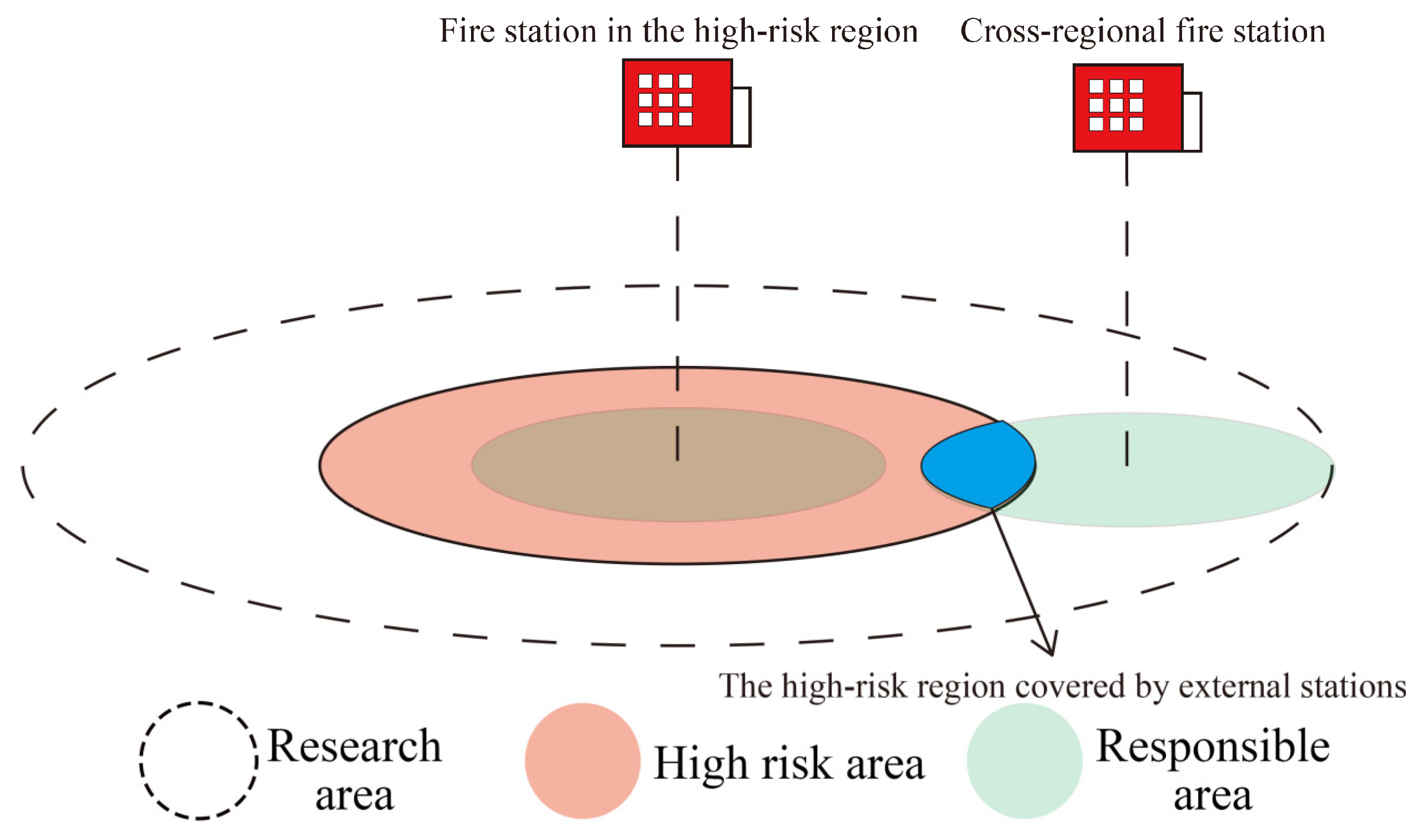
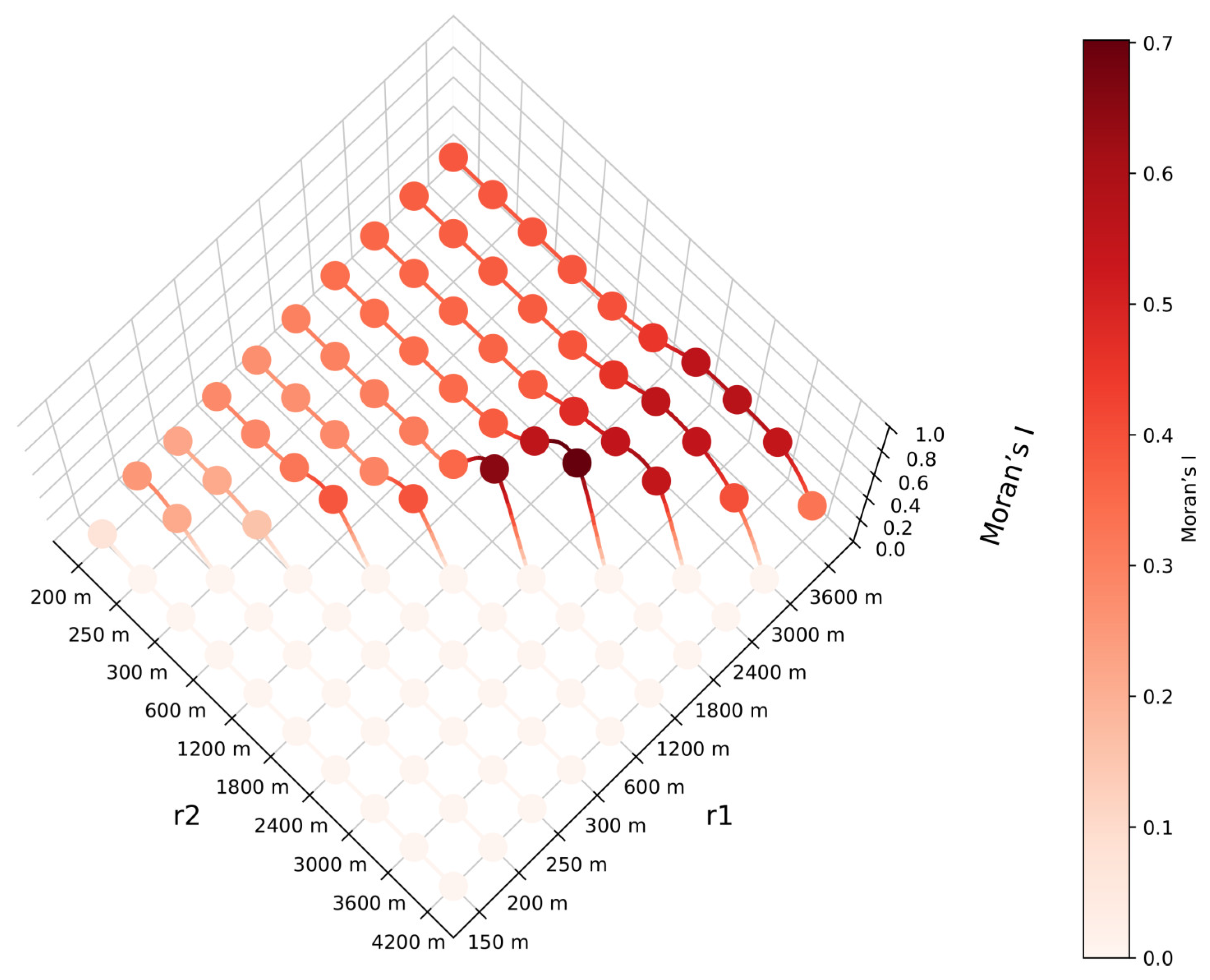
| Significant Stations Under LISA Check | H-H | H-L | L-H | L-L |
|---|---|---|---|---|
| 150 m | 2 | 1 | 4 | 0 |
| 200 m | 3 | 2 | 3 | 1 |
| 250 m | 7 | 1 | 1 | 3 |
| 300 m | 8 | 1 | 1 | 2 |
| 600 m | 9 | 0 | 1 | 7 |
| 1200 m | 11 | 0 | 0 | 9 |
| 1800 m | 12 | 0 | 0 | 9 |
| 2400 m | 12 | 0 | 0 | 9 |
| 3000 m | 11 | 0 | 0 | 11 |
| 3600 m | 12 | 0 | 0 | 10 |
| 4200 m | 12 | 0 | 0 | 11 |
| r2 | 150 m | 200 m | 250 m | 300 m | 600 m | 1200 m | 1800 m | 2400 m | 3000 m | 3600 m | 4200 m |
|---|---|---|---|---|---|---|---|---|---|---|---|
| r1 | |||||||||||
| 150 m | - | - | - | - | - | - | - | - | - | - | - |
| 200 m | 0.071 * | - | - | - | - | - | - | - | - | - | - |
| 250 m | 0.254 *** | 0.214 *** | - | - | - | - | - | - | - | - | - |
| 300 m | 0.224 *** | 0.214 *** | 0.157 *** | - | - | - | - | - | - | - | - |
| 600 m | 0.281 *** | 0.287 *** | 0.326 *** | 0.387 *** | - | - | - | - | - | - | - |
| 1200 m | 0.270 *** | 0.271 *** | 0.281 *** | 0.294 *** | 0.393 *** | - | - | - | - | - | - |
| 1800 m | 0.299 *** | 0.300 *** | 0.305 *** | 0.311 *** | 0.355 *** | 0.651 *** | - | - | - | - | - |
| 2400 m | 0.341 *** | 0.342 *** | 0.345 *** | 0.349 *** | 0.378 *** | 0.554 *** | 0.702 *** | - | - | - | - |
| 3000 m | 0.357 *** | 0.358 *** | 0.36 *** | 0.363 *** | 0.380 *** | 0.478 *** | 0.550 *** | 0.548 *** | - | - | - |
| 3600 m | 0.374 *** | 0.374 *** | 0.376 *** | 0.378 *** | 0.391 *** | 0.460 *** | 0.559 *** | 0.549 *** | 0.401 *** | - | - |
| 4200 m | 0.385 *** | 0.385 *** | 0.387 *** | 0.388 *** | 0.398 *** | 0.450 *** | 0.561 *** | 0.573 *** | 0.545 *** | 0.329 *** | - |
| Radius | Average Housing Price | Sampled POI Number |
|---|---|---|
| 150 m | 0.407 *** | 0.549 *** |
| 200 m | 0.485 *** | 0.590 *** |
| 250 m | 0.598 *** | 0.746 *** |
| 300 m | 0.613 *** | 0.747 *** |
| 600 m | 0.681 *** | 0.819 *** |
| 1200 m | 0.666 *** | 0.855 *** |
| 1800 m | 0.715 *** | 0.907 *** |
| 2400 m | 0.746 *** | 0.941 *** |
| 3000 m | 0.769 *** | 0.961 *** |
| 3600 m | 0.792 *** | 0.969 *** |
| 4200 m | 0.814 *** | 0.973 *** |
| Radius | Moran’s I | Moran’s I Under Micro Fire Station Strategy | Moran’s I Under Inter-Regional Firefighting |
|---|---|---|---|
| 150 m | 0.068 * | 0.494 *** | 0.068 * |
| 200 m | 0.124 ** | 0.49 *** | 0.124 ** |
| 250 m | 0.363 *** | 0.518 *** | 0.474 *** |
| 300 m | 0.425 *** | 0.522 *** | 0.64 *** |
| 600 m | 0.589 *** | 0.602 *** | 0.684 *** |
| 1200 m | 0.666 *** | 0.665 *** | 0.739 *** |
| 1800 m | 0.739 *** | 0.735 *** | 0.785 *** |
| 2400 m | 0.788 *** | 0.785 *** | 0.807 *** |
| 3000 m | 0.802 *** | 0.801 *** | 0.817 *** |
| 3600 m | 0.814 *** | 0.813 *** | 0.822 *** |
| 4200 m | 0.826 *** | 0.825 *** | 0.833 *** |
Disclaimer/Publisher’s Note: The statements, opinions and data contained in all publications are solely those of the individual author(s) and contributor(s) and not of MDPI and/or the editor(s). MDPI and/or the editor(s) disclaim responsibility for any injury to people or property resulting from any ideas, methods, instructions or products referred to in the content. |
© 2025 by the authors. Published by MDPI on behalf of the International Society for Photogrammetry and Remote Sensing. Licensee MDPI, Basel, Switzerland. This article is an open access article distributed under the terms and conditions of the Creative Commons Attribution (CC BY) license (https://creativecommons.org/licenses/by/4.0/).
Share and Cite
Li, J.; Hu, M. Mapping Spatial Inequity in Urban Fire Service Provision: A Moran’s I Analysis of Station Pressure Distribution. ISPRS Int. J. Geo-Inf. 2025, 14, 164. https://doi.org/10.3390/ijgi14040164
Li J, Hu M. Mapping Spatial Inequity in Urban Fire Service Provision: A Moran’s I Analysis of Station Pressure Distribution. ISPRS International Journal of Geo-Information. 2025; 14(4):164. https://doi.org/10.3390/ijgi14040164
Chicago/Turabian StyleLi, Jianyu, and Mingxing Hu. 2025. "Mapping Spatial Inequity in Urban Fire Service Provision: A Moran’s I Analysis of Station Pressure Distribution" ISPRS International Journal of Geo-Information 14, no. 4: 164. https://doi.org/10.3390/ijgi14040164
APA StyleLi, J., & Hu, M. (2025). Mapping Spatial Inequity in Urban Fire Service Provision: A Moran’s I Analysis of Station Pressure Distribution. ISPRS International Journal of Geo-Information, 14(4), 164. https://doi.org/10.3390/ijgi14040164






